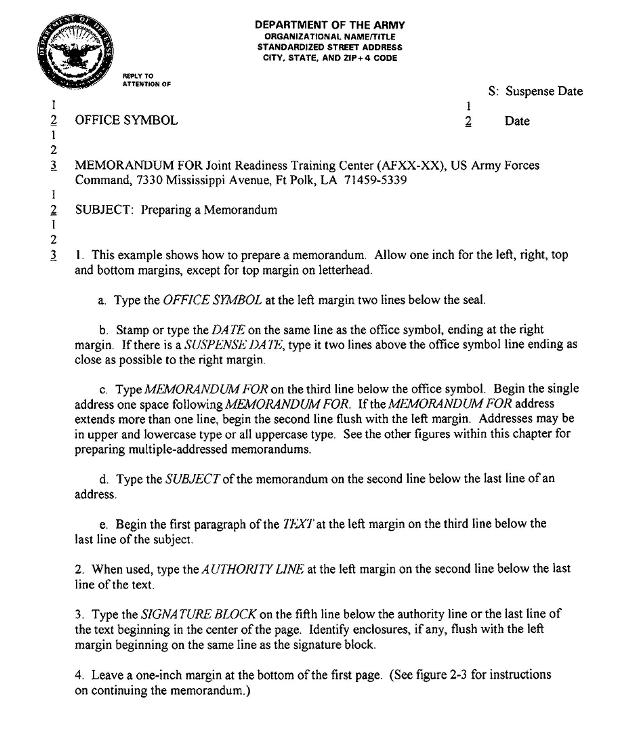Preparing memorandums
Format
When writing a memorandum, use the modified block style format. The format has three parts: heading, body, and closing.
a. Heading.
The heading has five elements:
(1) Office symbol. Type the office symbol on the second line below the seal. The symbol names the writer’s office (for example, DAPE–PRR). Do not use computer identification codes or word-processing codes as part of the office symbol. Other information may follow the office symbol when needed and if not part of the subject line. Some examples are the name of an individual, social security number, rank, primary military occupational specialty, contract number, or bill of lading number. Do not crowd the office or reference symbol line. If the additional information is lengthy, write it on a second line, flush with the left margin.
(2) Date.
(a) Put the date on the same line as the office symbol.
(b) End the date approximately even with the right margin.
(c) Express the date in this order: day, month, and year. Day—Express in numerals. Month—Spell out if the year is not abbreviated; abbreviate if the year is abbreviated (15 January 1999 or 15 Jan 99 but not 15 January 99 or 15 Jan 1999).
Year—Express either with two or four digits, depending on whether the month is abbreviated or spelled out. The only exception to this rule is if the date stamp uses the abbreviated month and the four-digit year.
(d) The date may be typed or stamped.
(3) Suspense date. Use a suspense date if a reply is needed by a certain date. Do not impose a suspense date when there is no compelling reason.
(a) Placement. Put the suspense date at the right margin on the same line as the Reply to Attention Of or two lines above the date of the memorandum.
(b) Setting of suspense date. Always consider the time factors involved, for example, transmission time to the reader, time the reader needs to gather the information, and transmission time for the return reply.
(c) Format of the date. See para 2.
(4) MEMORANDUM FOR line.
Type MEMORANDUM FOR on the third line below the office symbol. Write to the office that is expected to complete the action. Do not simply address an action to a headquarters if it is known which element of that headquarters will receive the action. If the memorandum is sent to someone’s attention, place the person’s name in parentheses after the office symbol. Exception: When used for Exclusive For correspondence, appreciation, and commendation, a memorandum will be addressed to name and title of the addressee. When a second line is needed for the address, begin it flush with the left margin, except for multiple-address memorandums, which will begin under the third character of the line above it. Type addresses in either all uppercase or upper- and lowercase type. Be consistent. Do not mix the two type styles.
(5) Subject line.
Type the subject line on the second line below the last line of the address. Use only one subject and write the subject in 10 words or less, if possible. If the subject needs more than 10 words, limit the number of words and use authorized abbreviations. If the subject is more than one line, begin the second line flush with the left margin. Type SUBJECT: in uppercase letters (see examples).
b. Body (Text).
Begin the text on the third line below the last subject line.
(a) If there are references, list these in the first paragraph.
(b) Begin the memorandum with a short, clear purpose sentence.
(c) Put the recommendation, conclusion, or most important information (the main point) next. (Some writing combines the purpose and the main point.)
(d) Clearly separate each major section. Use paragraphs, headings, or sections.
(e) When appropriate, a point of contact (POC) line will be the last paragraph of the body of the correspondence.
(2) Spacing.
Single-space the text with double-spacing between paragraphs and subparagraphs. Single-space one-paragraph memorandums.
(3) Indenting.
When paragraphs are subdivided, indent them as shown in figure 1.
(4) Numbering paragraphs.
(a) Do not number a one-paragraph memorandum.
(b) If the memorandum has more than one paragraph, number the paragraphs as outlined in figure 1.
c Closing.
Major elements are the authority line, signature block, and enclosure listing. Sub-elements are the DISTRIBUTION listing (if needed) and Copies Furnished (CF).
(1) Authority line.
Type the authority line at the left margin in uppercase letters on the second line below the last line of the text. The authority line is used by individuals properly designated as having the authority to sign for the commander or the head of an office.
FOR THE COMMANDER
R. L. SCOTT
Major General, GS
Chief of Staff
FOR THE COMMANDER
MATTHEW H. PACHOSA
Lieutenant Colonel, AG
Adjuctant General
(2) Signature block.
See example.
| John Jones Colonel, USA Retired | Robert Brown Captain, AUS Retired |
| F.A. Smith Major, AUS Retired | George May Major, USAR Retired |
| (Note: There is no special signature blocks from retired civilians) | |
(a) Placement.
Begin the signature block in the center of the page on the fifth line below the authority line. If there is no authority line, begin it on the fifth line below the last line of the text.
(b) Omission.
Omit the signature block if it is not known at the time of writing who will sign. The signature block may be added either by typing or by use of a rubber stamp at the time of signature.
